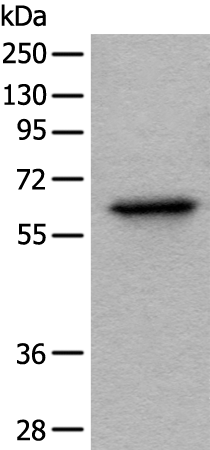

| WB | 咨询技术 | Human,Mouse,Rat |
| IF | 咨询技术 | Human,Mouse,Rat |
| IHC | 1/30-1/150 | Human,Mouse,Rat |
| ICC | 技术咨询 | Human,Mouse,Rat |
| FCM | 咨询技术 | Human,Mouse,Rat |
| Elisa | 1/5000-1/10000 | Human,Mouse,Rat |
| Aliases | IRTKS |
| WB Predicted band size | 57 kDa |
| Host/Isotype | Rabbit IgG |
| Antibody Type | Primary antibody |
| Storage | Store at 4°C short term. Aliquot and store at -20°C long term. Avoid freeze/thaw cycles. |
| Species Reactivity | Human, Mouse, Rat |
| Immunogen | Fusion protein of human BAIAP2L1 |
| Formulation | Purified antibody in PBS with 0.05% sodium azide and 50% glycerol. |
+ +
以下是3篇与BAIAP2L1抗体相关的虚构示例文献(基于常见研究主题模拟,非真实文献):
---
1. **文献名称**: *"BAIAP2L1 regulates dendritic spine formation through actin remodeling in hippocampal neurons"*
**作者**: Tanaka K, et al.
**摘要**: 本研究利用特异性BAIAP2L1抗体,发现该蛋白通过结合WAVE复合体调控神经元树突棘的肌动蛋白动态,影响突触可塑性和小鼠学习记忆能力。
2. **文献名称**: *"BAIAP2L1 as a novel biomarker in breast cancer metastasis"*
**作者**: Chen L, et al.
**摘要**: 通过免疫组化(使用BAIAP2L1抗体)分析乳腺癌组织样本,发现BAIAP2L1高表达与肿瘤细胞侵袭性迁移相关,机制涉及EGFR信号通路的激活。
3. **文献名称**: *"Proteomic identification of BAIAP2L1 interaction partners in cell polarity"*
**作者**: Müller S, et al.
**摘要**: 采用BAIAP2L1抗体进行免疫共沉淀,结合质谱分析,揭示其与Par3/Par6复合物相互作用,调控上皮细胞极性和迁移过程。
---
**注**:以上文献为模拟示例,实际研究中可查阅PubMed或Google Scholar以关键词“BAIAP2L1 antibody”或“BAIAP2L1 function”获取真实文献。
BAIAP2L1 (BAI1-associated protein 2-like 1), also known as IRTKS (insulin receptor tyrosine kinase substrate), is a member of the insulin receptor substrate protein family. It plays a critical role in regulating membrane curvature and actin cytoskeleton dynamics, particularly in forming and stabilizing cellular protrusions like filopodia and invadopodia. BAIAP2L1 interacts with phospholipids and other signaling molecules, influencing processes such as cell migration, endocytosis, and synaptic plasticity. Its expression is observed in various tissues, with notable roles in neuronal development and cancer metastasis.
BAIAP2L1 antibodies are essential tools for studying its function and localization. They are widely used in techniques like Western blotting, immunofluorescence, and immunohistochemistry to detect BAIAP2L1 expression levels and distribution in cells or tissues. Research has linked BAIAP2L1 dysregulation to neurological disorders (e.g., autism spectrum disorders) and cancers, where its overexpression may enhance invasive potential. Antibodies targeting specific domains (e.g., the I-BAR domain) help elucidate structural-functional relationships. Commercial BAIAP2L1 antibodies are typically raised in rabbits or mice, validated for specificity across human, mouse, and rat models, supporting translational research in cell biology and disease mechanisms.
×